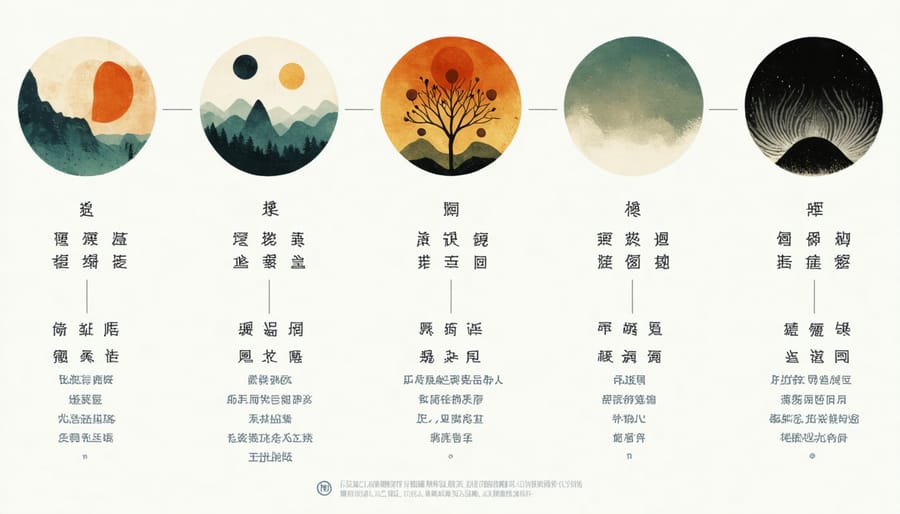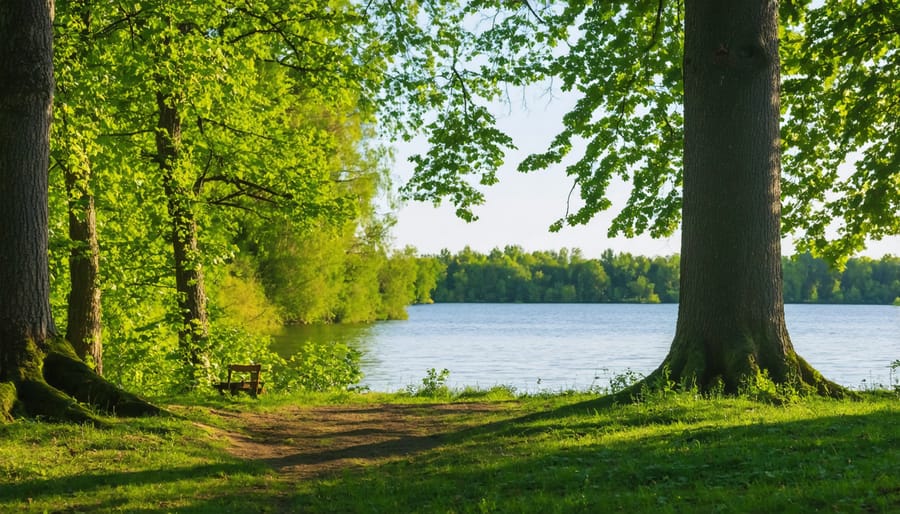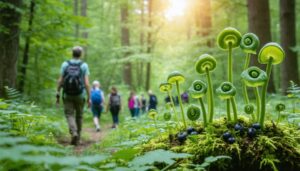Harness the ancient wisdom of qigong’s six healing sounds to transform your physical and emotional wellbeing through the power of intentional vibration. When practiced amid the tranquil settings of sound healing in Ontario’s parks, these sacred tones create a profound resonance with nature’s own healing frequencies. Each sound – Xu, He, Hu, Si, Chui, and Xi – corresponds to specific organ systems and emotional states, offering a gentle yet powerful way to release stress, balance energy, and promote natural healing. Whether you’re a seasoned practitioner or new to energy work, these traditional sounds provide a accessible pathway to deeper wellness, particularly when practiced in the pristine wilderness where the earth’s natural rhythms enhance their therapeutic effects. By combining breath, sound, and movement in outdoor settings, you’ll tap into a practice that has helped countless generations maintain harmony of body, mind, and spirit.
The Power of Sound in Nature’s Cathedral
Imagine practicing qigong sound healing while surrounded by towering pines, with sunlight filtering through the canopy and a gentle breeze carrying the scent of cedar. There’s something magical about combining the ancient art of sound healing with the natural acoustics of Ontario’s forests and parks.
Nature acts as a remarkable amplifier for healing sounds, creating what practitioners often call a “natural cathedral.” The open spaces allow sound vibrations to travel freely, while the presence of trees and rocks creates subtle echoes that enhance the resonance of each healing sound. This natural enhancement isn’t just poetic – it’s based on the scientific principle of sound reflection and absorption in outdoor spaces.
Many practitioners report deeper healing experiences when practicing in natural settings, noting that the combination of fresh air, natural sounds, and healing vibrations creates a more profound sense of well-being. The background symphony of birdsong, rustling leaves, and flowing water adds layers of natural harmony to your practice.
For beginners, starting your sound healing journey outdoors can also help overcome self-consciousness about making sounds in public. The privacy of a secluded trail or quiet meadow provides the perfect setting to explore your voice freely. Plus, the grounding energy of nature helps stabilize and amplify the healing effects of each sound.
Try finding a special spot in your local park or conservation area where you feel connected to nature. Early morning or sunset hours often provide the most peaceful conditions for practice.


The Six Healing Sounds of Qigong
Lung Sound (Sss) – Clearing Metal Energy
The lung sound “Sss” connects us deeply with the cleansing power of fresh air, making it perfect to practice while exploring Ontario’s pristine forests. As you make this gentle hissing sound, imagine releasing stale energy and drawing in nature’s vitality. This sound is particularly effective when combined with other breathing techniques in nature. To practice, sit comfortably, take a deep breath, and exhale slowly while making the “Sss” sound, letting your shoulders relax naturally. Feel the metal element’s clarity washing through you, much like a crisp autumn breeze clearing away fallen leaves. This sound is especially powerful during dawn or dusk when the air feels most pure and energizing. Try practicing near a trickling stream or in a pine grove where the air quality naturally enhances the healing effects.
Kidney Sound (Choo) – Flowing Water Energy
The kidney sound, pronounced “Choo,” resonates with the flowing energy of water in nature. Like a gentle stream meandering through Ontario’s forests, this sound helps release fear and anxiety while restoring your natural energy flow. When practicing this healing sound, imagine yourself beside a peaceful creek, letting the sound flow from deep within your lower abdomen.
To make the kidney sound, sit comfortably and form your mouth as if gently blowing out a candle. As you exhale, create a soft “Choo” sound while visualizing cool, blue energy circulating through your body. This sound is particularly effective when practiced near moving water, where the natural environment amplifies its healing properties.
For best results, practice this sound in the early morning or during the quieter evening hours when you can fully connect with water’s calming essence. Many practitioners find that combining the kidney sound with gentle swaying movements enhances its effectiveness in balancing the body’s water element.
Liver Sound (Shh) – Growing Wood Energy
Just as trees in a forest sway gently in the breeze, the liver sound “Shh” connects us to the growing energy of wood. This gentle sound, made by placing your tongue behind your upper teeth and exhaling softly, mimics rustling leaves and helps release anger while promoting emotional balance. Practice this sound while visualizing yourself in a peaceful forest setting, feeling the expansive energy of growing trees flowing through you. The liver sound is particularly powerful during spring when wood energy is strongest in nature. For the best experience, try this practice in the early morning hours between 1-3 AM, when liver energy peaks according to Traditional Chinese Medicine. As you make the sound, imagine a healing green light spreading throughout your body, just like sunlight filtering through a forest canopy.
Heart Sound (Haw) – Radiating Fire Energy
As the sun sets and paints the sky in warm hues, it’s the perfect time to practice the heart sound “Haw.” Find a peaceful spot facing west, sit comfortably, and place your hands over your heart center. As you exhale, make the “Haw” sound, letting it resonate from deep within your chest. This healing vibration is believed to release excess fire energy from the heart, helping to calm emotions like anxiety and overstimulation.
The heart sound practice is particularly powerful during sunset when the day’s energy naturally begins to settle. Imagine a gentle red light radiating from your heart as you make the sound, carrying away any emotional tension or scattered thoughts. Practice 6-8 repetitions, allowing each sound to flow smoothly and naturally. You might notice a sense of emotional balance and inner peace developing with each breath.
For the best experience, try this practice in a quiet garden or park where you can connect with nature’s tranquil evening energy.
Spleen Sound (Who) – Earth Energy
The spleen sound “Who” (pronounced “whoooo”) connects us deeply with Earth’s nurturing energy. As you practice this sound, imagine yourself grounded like a mighty oak tree, with roots extending deep into the soil. Find a quiet spot in nature, perhaps against a sturdy tree trunk or seated comfortably on a grassy knoll. Place your hands gently on your belly, just below your ribs where the spleen meridian flows. As you make the “Who” sound, visualize golden Earth energy rising through your feet and filling your entire body with strength and stability. This healing vibration is particularly effective for balancing digestion and boosting energy levels. Try practicing at dawn or dusk when the Earth’s energy is most receptive, and you’ll likely notice a wonderful sense of being centered and supported by nature’s embrace.
Triple Warmer Sound (Hee) – Temperature Regulation
The Triple Warmer sound “Hee” helps regulate body temperature and balance the nervous system. Practice this sound while sitting comfortably, ideally during sunrise or sunset when nature’s energy transitions are most potent. As you make the “Hee” sound, visualize gentle warmth spreading throughout your body, like sunshine filtering through tree branches.
This healing sound is particularly beneficial during seasonal changes, helping your body adapt to temperature fluctuations. Make the sound softly and slowly, allowing your breath to flow naturally. Some practitioners find it helpful to place their hands on their lower back while making the sound, as this area corresponds to the Triple Warmer meridian.
For optimal results, practice this sound three to six times in succession, taking brief pauses between repetitions. Many find that combining this practice with a peaceful walk in nature enhances its effectiveness.
Best Ontario Parks for Sound Healing Practice
Ontario’s parks offer serene natural settings perfect for practicing the six healing sounds of qigong. While many visitors enjoy meditation retreats in Ontario parks, these locations are equally ideal for sound healing practices.
Algonquin Provincial Park’s Lookout Trail provides elevated spots away from busy areas, where practitioners can freely vocalize without disturbing others. The morning hours at Mizzy Lake Trail offer pristine silence, perfect for combining your practice with sunrise observation.
In Bruce Peninsula National Park, Indian Head Cove creates natural acoustics that enhance your healing sounds. Visit during off-peak hours to find solitude among the limestone cliffs. The gentle lapping of Georgian Bay waters adds a harmonious backdrop to your practice.
Killarney Provincial Park’s The Crack trail summit offers secluded spots where your healing sounds can resonate freely. The crystalline quartzite hills create an energetically charged environment ideal for qigong practice.
For those near Toronto, Rouge National Urban Park provides accessible practice locations. The Vista Trail’s quiet corners, especially early morning or late evening, offer peaceful spots surrounded by meadows and forests.
Pro tip: Always scout your location first and practice during less crowded times, typically early mornings or weekdays. Consider bringing a small cushion for comfort and dress in layers to adapt to changing temperatures. Remember to respect wildlife and maintain appropriate distance from other park visitors during your practice.

Practical Tips for Park Sound Healing Sessions
Getting the most from your outdoor sound healing practice starts with choosing the right time and setting. Early morning, particularly around sunrise, offers pristine conditions with minimal background noise and crisp, clean air that carries sound beautifully. The evening hours just before sunset can be equally magical, as the day’s activities wind down and nature prepares for rest.
Weather plays a crucial role in your practice. Aim for clear, calm days when wind won’t interfere with your sounds. Light clouds are fine, but avoid practicing during rain or high humidity, which can affect both your comfort and the sound’s resonance. In winter, find a sheltered spot away from harsh winds, and remember to keep your sessions shorter to stay comfortable.
Choose a location that feels both peaceful and energizing. Look for clearings surrounded by trees, which naturally absorb excess sound and create a protective acoustic bubble. Natural amphitheaters formed by rock formations or hillsides can enhance your practice by providing gentle sound reflection.
For the best experience, arrive at your chosen spot 10-15 minutes early to settle in and observe the natural rhythms around you. Bring a comfortable cushion or mat to sit on, and dress in layers to adapt to changing temperatures. Consider bringing a friend for your first few sessions – sharing the experience can help you feel more confident practicing in public spaces.
Remember to be mindful of other park visitors and choose spots that won’t disturb wildlife or other people’s enjoyment of the space.
Ontario’s natural landscape provides the perfect sanctuary for practicing the six healing sounds of qigong. From the tranquil shores of the Great Lakes to the serene wilderness of Algonquin Park, our province offers countless pristine locations where you can connect with nature while engaging in this ancient healing practice. The combination of qigong’s restorative power and Ontario’s breathtaking outdoor spaces creates a unique opportunity for both physical and spiritual wellness. Whether you’re practicing among towering pines, beside rushing waterfalls, or in a peaceful meadow, these healing sounds take on new meaning when performed in harmony with nature’s own music. Make the most of Ontario’s natural beauty by incorporating these traditional Chinese healing techniques into your outdoor adventures, creating a deeply personal and transformative experience that honors both ancient wisdom and our province’s spectacular wilderness.













+ There are no comments
Add yours